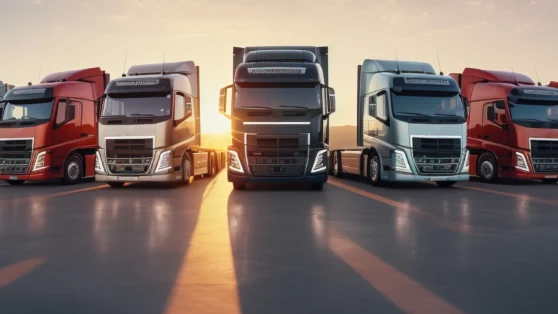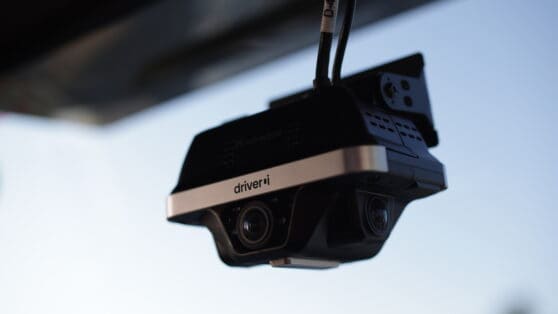Formal fleet safety programs are more important than ever these days, considering that fleet vehicle accidents on U.S. roadways are on the rise.
The trend is so pronounced that last January the Federal Motor Carrier Safety Administration (FMCSA) announced that it will conduct its first large truck crash study in more than 15 years. The move is motivated by a sharp increase in fatal crashes involving large trucks — they skyrocketed 52.6% between 2009 and 2018. The FMCSA points out that during that time “many changes in technology, vehicle safety, driver behavior, and roadway design have occurred that affect how a driver performs.”
In this context, fleet safety solutions are a necessity to shield your employees and company from risk. These accidents not only cause damage to vehicles, bad publicity that can ding your reputation, and potential injury or death to drivers. They can also be extremely costly. Juries are apt to give large awards in cases involving commercial vehicle crashes.
Simply put, you need a safe fleet — and for that, you need a vehicle safety program that includes a fleet safety training program.
A fleet safety program lays out the policies and procedures that will ensure your drivers are as safe as possible on the road. These programs prevent accidents, but also put safeguards in place to help exonerate the company and its employees if one happens to occur.
Here is everything you need to know about fleet safety.
The importance of fleet safety
Fleet safety is so crucial because it prevents a whole range of adverse outcomes that result from truck crashes. It’s easy to overlook the many problems that flow from a truck accident beyond the obvious.
For instance, here are some of the things you can hope to avoid by instituting a robust fleet safety program:
- Damage to the truck and its cargo
- Towing, storage and repair costs for the damaged truck
- Down time for damaged equipment
- Costs of medical care for the driver or others
- Employees missing work due to injury
- Hiring replacement drivers
- Workers’ compensation premiums
- Administrative fees and time
- Lawyers’ fees and court settlement costs
- Increased insurance costs
- Damaged business reputation
- Loss of established clients
- Increase stress burden
As you can surmise from this list, the fallout from a truck crash can create some pretty epic headaches for trucking company, and can even be enough to hobble a smaller fleet. It’s no question that there are many reasons to invest in fleet safety and develop a robust safety solution. Carefully setting up a formal safety program is the antidote to this problem.
Elements of a fleet safety program
It should go without saying, but it’s essential to build an effective fleet safety management program for your company. It’s easy to throw a few rules together and tell your drivers to follow them, but will that really substantively reduce risk? What you need is something that will really work – a systematic program that lays out fleet safety program elements, looks at the risk, and improves safety across your operations.
What are the elements of a safety program? Here are a number to think about when considering how to create a safety program of your own.
Hire the right fleet drivers
The first step in improving vehicle safety management for your fleet is hiring drivers who have the skills to drive safely and the enthusiasm to engage in a fleet safety program. They will need to take responsibility for cultivating safe driving behaviors and be willing to undergo coaching about elements of defensive driving when corrections are needed.
Define goals and create a plan
Before you start designing the methods you will use to increase safety, define your company’s goals for a fleet safety program and create a plan for reaching them. Goals should be as specific as possible, such as reducing unsafe driving behaviors by a certain percentage or reducing accidents to a specific number. Next, lay out the strategies and tactics you plan to put in place, such as training, coaching, clear policies and rules, communications procedures, and technological tools.
Implement your safety program and policy
When implementing the plan you’ve laid out, start with transparent communication about the plan details and new fleet safety policy to drivers and other employees. This is an essential piece of setting expectations about what is expected and what consequences will ensue if expectations are not met. It’s essential that you get driver buy-in before you start in order to increase cooperation and reduce friction. Next, put all your plans in place, keeping employees apprised of changes and requirements as you go.
Improve fleet safety and driver behavior
Once your system is up and running, don’t forget the importance of consistent coaching and training. Training drivers is an essential piece of improving driver safety — it’s the foundational way to ensure they are following fleet safety rules and driving safely. Coaching drivers on an ongoing basis can help them continue to maintain good habits and receive needed corrections for any dangerous practices. Tools like a Netraydne’s Fleet Safety Camera can provide real-time automated coaching and in-cab alerts to help drivers identify problems and practice defensive driving at all times.
Develop a positive driver safety culture
Developing a positive driver safety culture is the key element to ensuring employee engagement in the fleet safety program. And engagement is essential to success: Statistics show that disengaged employees have 49% more accidents (in general, not just in trucking), and make 60% more errors.
Rewards and incentives, including gamification, are a powerful way of cultivating a positive culture of safety. Give recognition to those who maintain a good safety record or cultivate specific habits that increase safety. For example, creating a driver of the month program can help motivate your drivers to do their best. Gamifying progress by allowing drivers to unlock awards through positive actions can be really motivating. Other ways to create a culture of encouragement is to feature safe drivers in company publications, have the CEO give out certificate or commendations, and give bonuses to those with A+ safety records.
Ensure vehicle maintenance
No fleet safety program would be complete without regular and comprehensive vehicle maintenance. It won’t matter how safe your drivers’ behaviors are if they’re driving around in unsafe rigs that are insufficiently maintained. Keep to a strict schedule and invest in proper vehicle care.
Why invest in dash cams?
The dash cam is a revolutionary tool to enhance your fleet safety program. This is especially the case if the dash cam is part of a complete driver safety system that marries multiple cameras with AI technology and edge computing to provide drivers safety input in real-time.
You may be wondering, “Is a dash cam worth it?” A best-quality dash cam can be costly, but nothing’s more valuable than fleet health and safety.
It’s important to choose the top dash cam system for your fleet, so start by learning about how they work, their benefits, and the features that will help you most.
How dash cams work
Small cameras usually placed in the front or back windows of a vehicle, dash cams can either record continuously or start recording when triggered by an incident like hard breaking or rapid accelerating. Dash cams that are set to continuously record are more likely to catch behaviors that create dangerous situations, such as distracted or aggressive driving. Such behaviors are major fleet challenges, so having a way to monitor for them is of great benefit to fleet managers.
Advanced dash cams that are more appropriate for commercial fleets are WiFi-enabled and send footage to be stored and analyzed in the Cloud in real-time. Such systems may include front-facing dash cams, rear-facing dash cams, dual-facing dash cams, and/or in-cabin cameras.
Dash cam benefits
Dash cams have many benefits for commercial fleets and the drivers that work for them. With the right coaching and positive culture surrounding safety, drivers start to understand the benefits of these tools to their careers and their safety. They see that they are more likely to keep their jobs if the company is thriving, and a poor safety record will damage that security.
Here are some benefits of dash cams that both fleets and drivers can appreciate:
Reducing distracted and aggressive driving:
Dash cams can provide fleets and drivers a window into how incidents occur in order to learn from these events and do better in the future. AI-enabled systems with real-time alerts, like Netradyne Driveri, offer drivers powerful tools to help maintain focus and drive as safety as possible.
Increasing safety compliance:
Dash cams can help keep the fleet in good standing with the Federal Motor Carrier Safety Administration (FMCSA), which uses its Compliance, Safety, Accountability (CSA) scores to identify which motor carriers pose risks in traffic. The feedback drivers get from dash cam systems help them cultivate the kind of defensive driving that results in a good CSA score for the company.
Getting drivers exonerated:
Dash cams provide video evidence of what happened during an incident on the road, especially the more advanced systems that record continuously. Since car drivers cause 80 percent of car-truck crashes, according to the American Trucking Association, fleets have a high incentive to save continuously recorded footage to help get their drivers exonerated from blame.
Do dash cams lowering insurance?
The average cost of fleet insurance for semi-trucks that are leased from a carrier is $3,000 to $5,000 per truck per year, while it’s much higher — $9,000-$12,000 — for owner-operators.
Some insurance carriers might provide a discount to commercial vehicles that use dash cams, fleet safety analytics, driving safety support systems, and other fleet management best practices.
Insurance companies also know that trucking companies with strong safety cultures usually have lower rates of traffic accidents. A company safety program that incorporates best-rated dash cams is a key indicator of a culture that promotes commercial fleet safety.
Choosing the best dash cam
What is a good, quality dash cam? The best vehicle cameras for a fleet’s needs is likely to be a driver safety platform that incorporates dash cams with other technology to provide the greatest benefits. Top-rated dash cameras on retail sites may be great for regular passenger vehicles but typically won’t suffice for commercial fleets.
Choosing the best dash cam for driver fleet safety starts with laying out the tasks you’d like the system to perform. Do you want continuous footage so you’ll always have the right evidence on hand in case of any problem? Do you want to see in-cabin footage to analyze how the driver’s behavior contributed to safe or unsafe situations? Do you want to monitor loading and unloading with a rear-facing camera? Do you want the driver to have real-time in-cabin alerts about dangers and problems?
Dash cam features you need
As a fleet, you are likely to benefit from the most advanced dash cam system features on the market. Here are some options you can look into to see what will serve you best:
- Artificial intelligence: Using AI, advanced dash cam systems can analyze driving behavior in real-time and provide useful analysis.
- WiFi: Advanced dash cam systems have WiFi to connect to the Cloud, providing safe and adequate storage for continuous recording.
- Positive driving recognition: A dash cam system may be able to analyze when a driver is using safe defensive driving techniques.
- Event detection: Dash cam systems may use various sensors to identify changes in speed or direction that indicate an unusual event is occurring.
- In-cab alerts: Some dash cam systems will alert drivers to dangerous situations or problematic driving behaviors in real time.
- Coaching program: More advanced dash cam systems include automated coaching programs that help drivers stay as safe as possible.
- HD video quality: The best dash cams record in high-quality video so that evidence will be clear and unequivocal.
- Easy installation: Even the most advanced dash cam systems don’t have to be difficult to install.
Should I get my fleet safety certified?
One of the safe fleet solutions gaining popularity is fleet safety certification.
Know the ROI of your fleet safety program
Instituting a fleet safety program is no small task, and of course you’ll want to know how all that effort and investment is benefiting the company. Keep track of metrics so that you can know the ROI of your fleet program and adjust course if it isn’t measuring up to expectations. Think of it as your “safety ROI.”
How do you measure your program’s ROI?
When judging the ROI of your fleet safety program, take into consideration to what extent the system is doing the following:
Reducing costs from accidents:
Keep track of accidents that occur both before and after you institute the program, making note of who was at fault in each case and tabulating the costs associated with each. Look at the numbers six months after instituting your vehicle safety guidelines and compare them to the six months leading up to the change. How much have at-fault accidents decreased? How much have costs decreased?
Decreasing insurance-related costs:
As accidents and other moving violations decrease due to the new system, the costs associated with insuring the fleet should also go down. Compare the costs six months out to six months prior and see whether the change is benefitting the company.
Encouraging driver retention:
Look at employee records to determine whether retention has improved in the wake of implementing the new system. Are drivers out of work less often with injuries from accidents? Are drivers exhibiting higher morale and staying engaged more consistently? Put a dollar figure on the cost of turnover prior to installing the system and compare it to the turnover since the installation.
You can aggregate all these cost savings and come up with a specific number for the ROI of your fleet safety program. Chances are it will be well worth the cost of investment.
Final thoughts
Maintaining fleet safety is ongoing work: Drivers need continual encouragement, and technology must be maintained to the highest standard to ensure the best results. A driver safety program must be a serious and continuous effort.
Continue to improve your fleet safety with Netradyne’s top-of-the line fleet safety platform. It’s your job to help protect the road and your drivers, and Netradyne can help.






